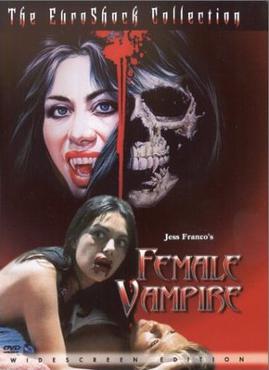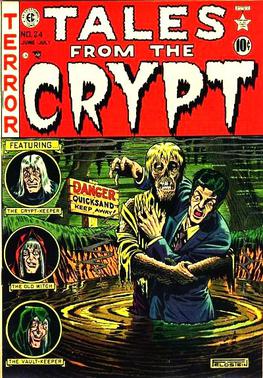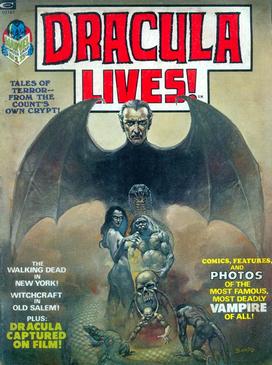
Jacula is the title character of an Italian eponymous erotic-horror fumetti series.

Jacula is the title character of an Italian eponymous erotic-horror fumetti series.
The character first appeared in a supporting role in the comic series Isabella . [1]
A total of 327 issues of Jacula were produced between 1969 and 1982. [1] [2] Reissues of stories were published between 1973 and 1984 in the series Jacula Collezione. [2]
In common with Zora and Sukia , the series contained strong sexual imagery: together with her vampire husband Carlo Verdier, the predatory Jacula seduced the unwary and corrupted the innocent. [1] She was also married to a human called Torlin Novak, and the relationship resulted in a child whose soul was promptly pledged to Satan. [3]

Buffy the Vampire Slayer is an American supernatural drama television series created by writer and director Joss Whedon. It is based on the 1992 film of the same name, also written by Whedon, although they are separate and otherwise unrelated productions. Whedon served as executive producer and showrunner under his production tag Mutant Enemy Productions.

Vampire literature covers the spectrum of literary work concerned principally with the subject of vampires. The literary vampire first appeared in 18th-century poetry, before becoming one of the stock figures of gothic fiction with the publication of Polidori's The Vampyre (1819), which was inspired by the life and legend of Lord Byron. Later influential works include the penny dreadful Varney the Vampire (1847); Sheridan Le Fanu's tale of a lesbian vampire, Carmilla (1872), and the most well known: Bram Stoker's Dracula (1897). Some authors created a more "sympathetic vampire", with Varney being the first, and Anne Rice's 1976 novel Interview with the Vampire as a more recent example.
Hammer Film Productions Ltd. is a British film production company based in London. Founded in 1934, the company is best known for a series of Gothic horror and fantasy films made from the mid-1950s until the 1970s. Many of these involve classic horror characters such as Baron Victor Frankenstein, Count Dracula, and the Mummy, which Hammer reintroduced to audiences by filming them in vivid colour for the first time. Hammer also produced science fiction, thrillers, film noir and comedies, as well as, in later years, television series.

The Tomb of Dracula is an American horror comic book series published by Marvel Comics from April 1972 to August 1979. The 70-issue series featured a group of vampire hunters who fought Count Dracula and other supernatural menaces. On rare occasions, Dracula would work with these vampire hunters against a common threat or battle other supernatural threats on his own, but more often than not, he was the antagonist rather than protagonist. In addition to his supernatural battles in this series, Marvel's Dracula often served as a supervillain to other characters in the Marvel Universe, battling the likes of Blade the Vampire Slayer, Spider-Man, the Werewolf, the X-Men, Howard the Duck, and the licensed Robert E. Howard character Solomon Kane.

Vampire Hunter D is a series of novels written by Japanese author Hideyuki Kikuchi and illustrated by Yoshitaka Amano since 1983.

Wilhelmina "Mina" Harker is a fictional character and the main female character in Bram Stoker's 1897 Gothic horror novel Dracula.

Vampire films have been a staple in world cinema since the era of silent films, so much so that the depiction of vampires in popular culture is strongly based upon their depiction in films throughout the years. The most popular cinematic adaptation of vampire fiction has been from Bram Stoker's 1897 novel Dracula, with over 170 versions to date. Running a distant second are adaptations of the 1872 novel Carmilla by Sheridan Le Fanu. By 2005, the Dracula character had been the subject of more films than any other fictional character except Sherlock Holmes.
Renzo Barbieri was an author and editor of Italian comics as well as the founder of the publishing house Edifumetto. In 1980 he wrote Il Manuale del Playboy, a textbook about where European playboys live, what cars they drive, and other lifestyle tips.

Vampires are frequently represented in popular culture, including appearances in ballet, films, literature, music, opera, theatre, paintings, and video games.

Lesbian vampirism is a trope in 20th-century exploitation film and literature. It was a way to hint at or titillate with the taboo idea of lesbianism in a fantasy context outside the heavily censored realm of social realism.

Female Vampire is a French-Belgian horror film written, directed, and co-edited by Jesús Franco. It was produced in 1973, but was only theatrically distributed in 1975. The film is set in Europe and stars actress Lina Romay as Irina von Karlstein, a vampire who has sex with both male and female victims. In an unusual variation of the vampire myth, Karlstein performs oral sex on her victims until they die, draining them of their sexual fluids.
LGBT themes in horror fiction refers to sexuality in horror fiction that can often focus on LGBTQ+ characters and themes within various forms of media. It may deal with characters who are coded as or who are openly LGBTQ+, or it may deal with themes or plots that are specific to gender and sexual minorities. Depending on when it was made, it may contain open statements of gender variance, sexuality, same-sex sexual imagery, same-sex love or affection or simply a sensibility that has special meaning to LGBTQ+ people.
"Welcome to the Hellmouth" is the series premiere of the American supernatural drama television series Buffy the Vampire Slayer. It originally aired on The WB on March 10, 1997 in a two-hour premiere along with the following episode, "The Harvest". The episode was written by the series creator and executive producer Joss Whedon and directed by Charles Martin Smith. "Welcome to the Hellmouth" received a Nielsen rating of 3.4 upon its original airing and received largely positive reviews from critics.
The character of Count Dracula from the 1897 novel Dracula by Bram Stoker, has remained popular over the years, and many forms of media have adopted the character in various forms. In their book Dracula in Visual Media, authors John Edgar Browning and Caroline Joan S. Picart declared that no other horror character or vampire has been emulated more times than Count Dracula. Most variations of Dracula across film, comics, television, documentaries predominantly explore Dracula as he was portrayed in film with only a few more closely adapting Stoker's original narrative. These including borrowing the look of Count Dracula in both the Universal's series of Dracula and Hammer's series of Dracula, including include the characters clothing, mannerisms, physical features hair style and his motivations such as wanting to be a nearby home away from Europe.

Horror comics are comic books, graphic novels, black-and-white comics magazines, and manga focusing on horror fiction. In the US market, horror comic books reached a peak in the late 1940s through the mid-1950s, when concern over content and the imposition of the self-censorship Comics Code Authority contributed to the demise of many titles and the toning down of others. Black-and-white horror-comics magazines, which did not fall under the Code, flourished from the mid-1960s through the early 1980s from a variety of publishers. Mainstream American color comic books experienced a horror resurgence in the 1970s, following a loosening of the Code. While the genre has had greater and lesser periods of popularity, it occupies a firm niche in comics as of the 2010s.

Zora is an Italian comic book erotic character from the 1970s. Zora la Vampira is one of many such characters from the Italian fumetti tradition. Other figures from the same era, and with similarly violent or erotic preoccupations, include Maghella, Lucifera, Biancaneve, Vartan, Jacula, Sukia, and Yra.
Yra the Vampire is the main character from the eponymous series of erotic comic books. She was drawn by Leone Frollo and Rubino Ventura. Her 12-episodes fumetti series, titled Yra, published from 1980 to 1981 in Italy by Edifumetto.
Jiangshi fiction, or goeng-si fiction in Cantonese, is a literary and cinematic genre of horror based on the jiangshi of Chinese folklore, a reanimated corpse controlled by Taoist priests that resembles the zombies and vampires of Western fiction. The genre first appeared in the literature of the Qing dynasty and the jiangshi film is a staple of the modern Hong Kong film industry. Hong Kong jiangshi films like Mr. Vampire and Encounters of the Spooky Kind follow a formula of mixing horror with comedy and kung fu.

Dracula Lives! was an American black-and-white horror comics magazine published by Magazine Management, a corporate sibling of Marvel Comics. The series ran 13 issues and one Super Annual from 1973 to 1975, and starred the Marvel version of the literary vampire Dracula.

Vampire: The Masquerade is a monthly horror comic book published by Vault Comics since 2020. It is based on the tabletop role-playing game of the same name, and is part of the larger World of Darkness series. The series is written by Tim Seeley, Tini Howard and Blake Howard, with art by Devmalya Pramanik, Nathan Gooden, David W. Mack and Aaron Campbell, coloring by Addison Duke, and lettering by AndWorld.